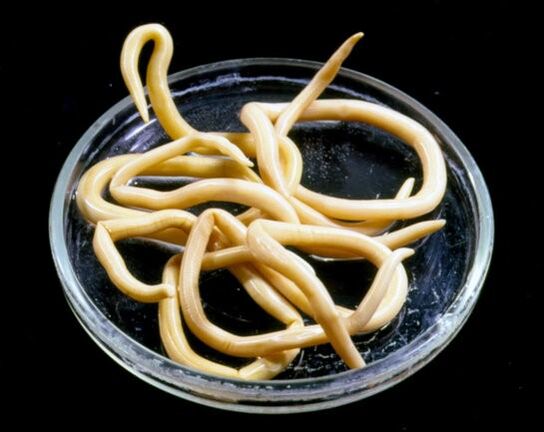The most common worms are human worms. These parasites in humans can cause a number of complications including: gastrointestinal disruption, physical damage to internal organs, helminthiasis.
Helminthiasis is not one disease but a group of diseases caused by parasites that live inside the human body. All worms are divided into 3 main types:
- Nematodes (belonging to the order Nematodes), prominent representatives - nematodes, pinworms, whipworms;
- tapeworms, or tapeworms (a flatworm), represented by tapeworms, bovine tapeworms;
- Liver flukes stand for trematodes or flukes (isolations of flatworms).
Since worms leave the host during the breeding season to protect the species, when transferring to another medium or environment, they are also divided according to the type of transfer:
- Mechanical transfer involves long-distance travel without creating worms within the carrier body. These include most arthropods (crustaceans, arachnids, and centipedes), which are usually carried by the legs of the common fly.
- An intermediate host is a specialized mode of transfer in which a developmental stage occurs within the host organism. For example, for bovine tapeworms, domestic animals serve as vectors (intermediate hosts) and humans serve as final vectors.
Worms vary according to how they spread:
- active(contact);
- Passive (food).
Contact worms can enter the body through mucous membranes and skin (schistosomes, hookworms). Foods are more common, and they develop in the body after eating uncleaned food, coming into contact with sick people, or not following personal hygiene rules.
There are more than 250 species of lower worms parasitic on humans in the world. Since the symptoms of worms in humans can vary, if you have the slightest doubt, you should consult a specialist and get checked.
Life cycle of worms, their reproduction and development
An example of worm development is the classic scheme of the nematode life cycle. The parasite eggs are extremely resistant to adverse external influences and can remain in the soil for up to six months.
The development of the larva itself takes 2 weeks to 2 months, depending on the environmental conditions: temperature, humidity, oxygen availability. Mature eggs with food enter the stomach, and gastric juices corrode the egg shell, releasing the larvae.

The worm then enters the bloodstream through the intestinal wall and begins to move throughout the vasculature until it enters the alveoli. The nematode larva is aerobic and only here it becomes active and continues to develop.
It feeds on blood and can grow up to 3-4 mm long. Primary maturity is reached 4-5 days after invasion and nematodes begin to enter the bronchi.
Its movement causes a person to cough, and as a result the larvae enter the mouth along with the mucus and return to the intestine. Here the final stages of adult larval formation take place.
The life cycle of an adult nematode lasts about a year, during which time it lays as many as 250, 000 eggs. Human health, and sometimes life, directly depends on the presence and number of worms in the body, so it is important to start treatment as soon as possible.
Ascariasis is accompanied by intoxication, and intestinal obstruction is a complication that in some cases requires urgent surgical intervention.
There are two ways for worms to reproduce, and worms are divided into biological worms and ground worms. Usually, the parasite eggs go to the external environment - where they mature. The egg must then enter a host, where it develops fully (geohelminths) or undergoes a stage of transformation into a larva (biohelminths).

In biological worms, the developmental process is more complex, and the developmental stages of the adult individual and the realization of maturity are separated from the emergence stage of the larvae. That is, from the perspective of the external environment, the eggs first enter the intermediate carrier, where the larvae hatch.
Therefore, he needs to enter the body of the last host to reach the adult form. Sometimes, worms alter up to 4 intermediate vectors before reaching the final host.
symptom
How to determine the presence of worms? Polymorphic symptoms and the absence of pain in the early stages of the disease make it difficult to diagnose.
The reason why worms appear in the human body is usually related to the consumption of stale or contaminated food, and the parasites themselves live directly in the digestive tract, so the signs of their presence in the human body are in most cases related to the work of the intestines:
- Liquid stools (unstable;
- pain and swelling;
- allergic rash;
- flatulence;
- nausea;
- he vomited;
- loss of appetite or loss of appetite;
- At night - sleep disturbances, throwing, teeth grinding, salivation;
- anal itching;
- Mucus or blood in the stool.
These symptoms appear and last for a short time (about 7 days) after infection. They will repeat after 2-3 weeks if re-infested.
Some symptoms do not go away without treatment or due to the presence of acute or chronic diseases, the consequences of the long-term persistence of parasites in the body are as follows:
- Intoxication occurs almost at the same time as infection, but it is not so obvious in the early stage. The more parasites in the human body, the more symptoms of poisoning, from morning sickness to vomiting and abdominal pain.
- Lung congestion (infiltration), bronchospasm, pneumonia. The culprit is a parasite that develops in the alveoli and damages them, causing inflammation.
- Inflammation of heart muscle (myocarditis). Contagion, the result of the vital activity of the worm and subsequent intoxication.
- Meningoencephalitis is a dangerous inflammation of the brain and its membranes caused by bacteria and protozoa.
Different pathogens have their own manifestations and consequences, but most symptoms are common to all worms.
diagnosis
Diagnosis is made in a laboratory. Only in this case, helminthiasis can be diagnosed with confidence in the presence of worm eggs and their signs in blood or stool. However, the analysis of feces is not always sufficient: certain types of parasites do not manifest themselves in it.
A specific method to determine the presence of worms is a serological blood test for antibodies. To diagnose helminthiasis, use:
- bile research;
- Macroscopic examination (to detect roundworms and pinworms);
- Muscle biopsy when checking for trichinosis;
- X-rays and ultrasound.
Trichinellosis is a parasitic disease in which the larvae of the pathogen spread throughout the body of the carrier, causing great damage to organs and the central nervous system, and then parasitic in muscle tissue.
The parasites in the muscles of a person gradually form an osmotic sac around themselves, their symptoms in the body decrease, but by this time they have already caused serious damage to the health of the host.

One of the main symptoms can be considered hypereosinophilia, in which the number of eosinophils in the patient's blood increases dramatically. Eosinophils are a subspecies of white blood cells that respond to tiny foreign objects present in the circulation.
In places where parasite larvae gather, internal swelling and skin spots - traces of infiltration soon appear. They are also found in sputum and lung fluid.
Since the symptoms of helminthiasis are broad and overlap considerably with signs of other diseases, self-diagnosis cannot be completely reliable.
In some cases, people have found black lines in their stool after eating bananas, which they believe are worms. Before starting treatment, it is necessary to pass tests for the presence and type of all parasites.
Helminth Treatment
During the treatment of parasitic diseases, several general rules must be observed:
- Thoroughly disinfect hospital bed sheets and the room they are in. To minimize contact, the boards should be separated.
- Follow a strict alcohol-free diet. Carrot juice and birch bud juice are recommended.
- Personal hygiene, frequent hand washing and laundry, house cleaning.
- Monitor the course of treatment and its effectiveness.
Modern treatments do not include the use of individual drugs, as this does not guarantee complete coverage of all types of parasites. In most cases, a doctor will prescribe an initial drug that weakens the parasite.
If it is not possible to consult a doctor, folk remedies are used. Work a good repellant by:
- Garlic infusion enema, take garlic on an empty stomach;
- Tansy infusion 4 times a day on an empty stomach before meals;
- Tincture of wormwood wine, 20 mg each time, 3 times a day.
The human worm of our time can be diagnosed and treated in a fraction of the time. This will help avoid complications and re-attacks if you don't start an attack and start treatment on time.
The greatest danger of parasitic diseases is children: intellectual development is delayed, complications appear in the form of chronic diseases, inflammatory processes.
It is very important to promptly explain to children the need to wash hands and observe personal hygiene rules. In the meantime, adults are asked to observe other precautions.
prevention of worms
In addition to personal hygiene, there are many factors that can affect eliminating the cause of worms:
- washing vegetables and fruits in hot water;
- Keep the house clean and perform regular wet cleaning;
- Eat a balanced diet that provides the body with adequate amounts of various vitamins;
- Monitor your pet's condition and visit the veterinarian annually;
- Appropriate heat treatment of fish and meat;
- against house-dwelling insects;
- Avoid bathing and resting in pastoral areas.
Following precautions and seeing a doctor promptly if you become infected will help avoid complications. Drugs in the correct dose prescribed by a specialist can quickly destroy the parasite, and folk remedies can be combined with prescription drugs.






































